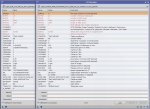I believe I have worked out what happened here; it's a bit complicated!

We are going to look at " Light_SH2-275_600.0s_Bin1_gain90_20210304-204206_-19.8C_0002.fit", which I will just call "SH2".
If you look at the FITS header of SH2 in a FITS viewer (such as FITS Liberator), you will see a quite different header to the one displayed if you load SH2 into PI:
Code:
SIMPLE = T / file does conform to FITS standard
BITPIX = 16 / number of bits per data pixel
NAXIS = 2 / number of data axes
NAXIS1 = 4944 / length of data axis 1
NAXIS2 = 3284 / length of data axis 2
EXTEND = T / FITS dataset may contain extensions
COMMENT FITS (Flexible Image Transport System) format is defined in 'Astronomy
COMMENT and Astrophysics', volume 376, page 359; bibcode: 2001A&A...376..359H
BZERO = 32768 / offset data range to that of unsigned short
BSCALE = 1 / default scaling factor
CREATOR = 'ZWO ASIAIR' / Capture software
OFFSET = 65 / camera offset
XORGSUBF= 0 / Subframe X position in binned pixels
YORGSUBF= 0 / Subframe Y position in binned pixels
FOCALLEN= 442 / Focal length of telescope in mm
EGAIN = 1.00057375431061 / Electronic gain in e-/ADU
XBINNING= 1 / Camera X Bin
YBINNING= 1 / Camera Y Bin
CCDXBIN = 1 / Camera X Bin
CCDYBIN = 1 / Camera Y Bin
XPIXSZ = 4.78000020980835 / pixel size in microns (with binning)
YPIXSZ = 4.78000020980835 / pixel size in microns (with binning)
IMAGETYP= 'Light ' / Type of image
EXPOSURE= 600. / Exposure time in seconds
EXPTIME = 600. / Exposure time in seconds
CCD-TEMP= -19.7999992370605 / sensor temperature in C
RA = 98.2026 / Object Right Ascension in degrees
DEC = 4.89836 / Object Declination in degrees
DATE-OBS= '2021-03-04T19:42:06.601' / Image created time
INSTRUME= 'ZWO ASI071MC Pro' / Camera model
BAYERPAT= 'RGGB ' / Bayer pattern
GAIN = 90 / Gain Value
TELESCOP= 'EQMod Mount' / Telescope name
CTYPE1 = 'RA---TAN-SIP' / TAN (gnomic) projection + SIP distortions
CTYPE2 = 'DEC--TAN-SIP' / TAN (gnomic) projection + SIP distortions
CRVAL1 = 97.8924335401 / RA of reference point
CRVAL2 = 5.65279346665 / DEC of reference point
CRPIX1 = 323.626228333 / X reference pixel
CRPIX2 = 423.537017822 / Y reference pixel
CD1_1 = 0.000307529599758 / Transformation matrix
CD1_2 = 0.00245990429904 / no comment
CD2_1 = -0.00245833912057 / no comment
CD2_2 = 0.000313085844039 / no comment
A_ORDER = 2. / Polynomial order, axis 1
B_ORDER = 2. / Polynomial order, axis 2
AP_ORDER= 2. / Inv polynomial order, axis 1
BP_ORDER= 2. / Inv polynomial order, axis 2
A_0_0 = 0. / no comment
A_0_1 = 0. / no comment
A_0_2 = -4.67633313285E-06 / no comment
A_1_0 = 0. / no comment
A_1_1 = 6.41107476689E-06 / no comment
A_2_0 = -2.9891817272E-07 / no comment
B_0_0 = 0. / no comment
B_0_1 = 0. / no comment
B_0_2 = 1.36915406576E-07 / no comment
B_1_0 = 0. / no comment
B_1_1 = -5.14498079084E-07 / no comment
B_2_0 = -3.23651389249E-07 / no comment
AP_0_0 = -0.00083198820658 / no comment
AP_0_1 = -3.25764060716E-06 / no comment
AP_0_2 = 4.6922110427E-06 / no comment
AP_1_0 = 2.95443551766E-06 / no comment
AP_1_1 = -6.41595078061E-06 / no comment
AP_2_0 = 2.97304247704E-07 / no comment
BP_0_0 = -7.25986741272E-06 / no comment
BP_0_1 = 6.76939933507E-08 / no comment
BP_0_2 = -1.37154745116E-07 / no comment
BP_1_0 = -6.21080938766E-08 / no comment
BP_1_1 = 5.12261404578E-07 / no comment
BP_2_0 = 3.24016955865E-07 / no comment
IMAGEW = 1236. / Image width, in pixels.
IMAGEH = 820. / Image height, in pixels.
In particular, note that "FOCALLEN=442", correctly.
However, the header already contains an astrometric solution
and it is wrong! The error is clear in the last two keywords: IMAGEW=1236, IMAGEH=820. Clearly this solution was produced from a 4x4 binned version of the image (probably some UI setting error when the solution was performed). This solution uses SIP parameters (the A..., B... parameters) to describe image distortion; I don't know what app was used, but Astrometry.net can generate SIP solutions. PI does not support this (the PI method of quantifying image distortion is much more accurate). To make the solution compatible with PI, PI has "hacked" the header, on input, to extract the linear (first order) part of the solution; it has then calculated the (missing) axis linear scaling factors CDELT1, CDELT2 (which can be worked out from the scale matrix). Then, using these and the pixel size (or some other derived parameter) it has "reverse engineered" the focal length - but since the solution is for a 4x4 binned image, the result is out by a factor of 4. The image RA and DEC are also "corrected" on the basis of the scaled solution, giving wrong values.
What you should really do is delete the (wrong) astrometric solution from the original FITS header, and solve the resulting image in PI.




